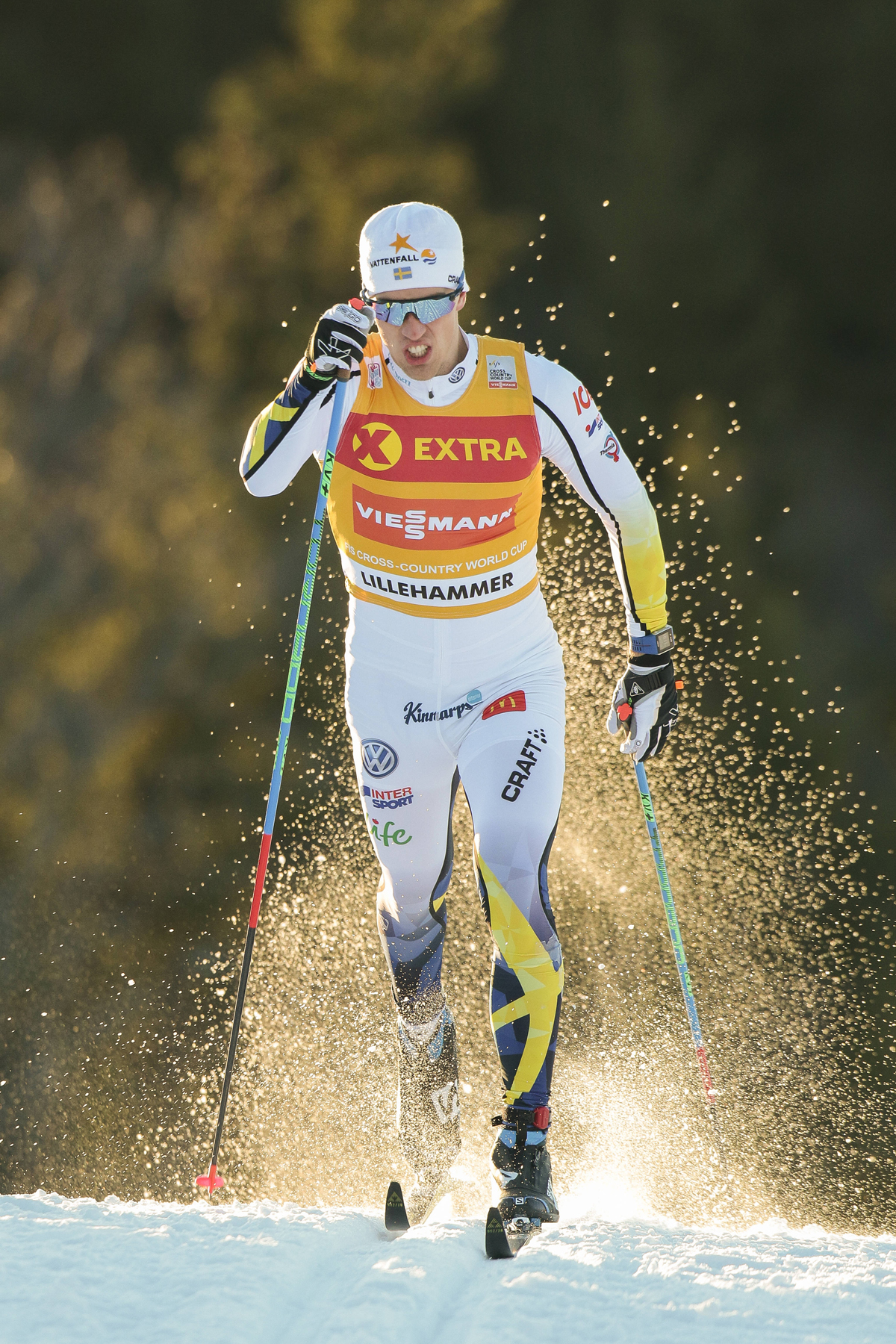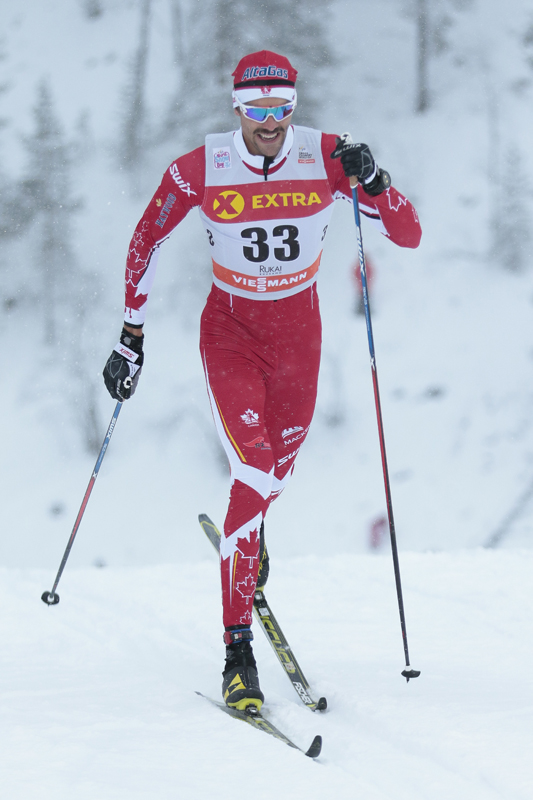
Blue skies. The low, northern-latitude light basking Lillehammer, Norway’s storied tracks in a sublime wintery hue.
That was only the setting for Friday’s 1.5-kilometer men’s classic sprint, the first stage of a three-day mini tour. The bucolic dreaminess was jolted by snow spraying off the backs of skis as the men charged up and down the three-hilled Lillehammer course.
Sweden’s Calle Halfvarsson came to Lillehammer wearing the yellow bib as the overall World Cup leader. By race the race’s end, with sprinters coming in and out of sub-Arctic shadow, Halfvarsson took the sprint win in 3:31.83, securing his early season grip on yellow. It was the Swede’s second podium in the season’s early chapters. He placed second in the World Cup’s opening day classic sprint in Kuusamo, Finland, last Saturday.
“I felt strong in the prologue and in all the heats,” Halfvarsson said during the post-race press conference. “I decided to go out of the track on the last climb because I had a better grip there. I think I am headed in the right direction. We will see tomorrow how things are.”
Halfvarsson shared the podium with Norway’s Emil Iversen in second (+0.12), and Swedish teammate Teodor Peterson in third (+0.54).
Ninety-eight men began the mini tour, setting off one by one during Friday’s sprint qualifier. From that initial 98, the field was culled to 30 skiers in the heats, 12 in the semis, six in the finals. And then of course there was one.
Halfvarsson began the day the same place he finished it: he was the first qualifier in 3:28.44. He moved through the rounds placing second in quarterfinal two, and first in semifinal one where he edged Peterson by 0.10 seconds.
Peterson qualified fourth, nearly six seconds behind Halfvarsson. Peterson then finished second in both his quarter and semi to advance to the finals, eventually placing third. “I’m satisfied with it, third is better than fourth and I feel like I tried my best in the final 100 meters but it didn’t work, though I’m still satisfied with the performance,” Peterson said during the press conference.
Iverson’s route to the podium began with a slightly slower turn of pace; he qualified 13th in 3:37.39. Like Peterson, he, too, finished second in his quarter and semifinal. During the final, Iversen appeared to have been dropped by Halfvarsson’s fast skis, strong surge on the final uphill, and his double pole fury. A full 10 meters appeared to separate the skiers coming into the home stretch.
“I always hope for a win, but second place is a good way to start the mini tour in Lillehammer,” Iversen explained when asked about his result at the press conference. “Being the best Norwegian of the day means I did a good job. The final was really fast. I tried my best on the final uphill, but Calle gained some meters and it was enough for him to win.”
Whatever distance there was between the eventual winner and Iversen was quickly diminished. Slotted right behind Halfvarsson, in the same lane, Iversen charged — eventually skiing onto the Swede’s tails a few meters from the finish. Iversen’s lunge for second place was a snazzy move; he swerved out and around Halfvarsson.
Iversen was unable to better position himself for the finish by moving into the adjoining lane; by doing so he would have obstructed Peterson and risked obstructing him. The takeaway from Iversen’s burly finish should be a big warning shot to potential rivals: the young Norwegian can close seemingly insurmountable gaps with a frenzied finishing move.
Of note, Norway’s Pål Golberg moved through the rounds with ease. Qualifying third and winning out until the final, Golberg’s sixth-place finish was cemented as soon as the starter’s gun fired. He snapped a pole at the start and did not receive immediate assistance from a coach for a pole replacement.
Valjas, Harvey, Bjornsen Qualify

Twelve North American men began the day’s race. Of those, only Canada’s Len Valjas, Alex Harvey, and U.S. Ski Team member Erik Bjornsen qualified for the sprint rounds.
Valjas placed 13th overall after qualifying 19th (+10.24).
Matching strides with eventual quarterfinal five winner Norwegian, Petter Northug, and last week’s 15 k classic winner in Kuusamo, Finland’s Livo Niskanen, Valjas initially looked posed to advance.
“I felt good warming up for the quarterfinal so yeah, I was hoping for a little bit more today,” Valjas told Cross Country Canada, according to a press release, after the race. “But I had a lot of fun out there. I was skiing in the front for most of [my quarterfinal]. I don’t know, I felt really good and just got kind of boxed in coming into the finishing straight, so I jumped between the tracks, and it was just not enough, I couldn’t, or I needed a little more room to pass one more guy.”
Valjas skied to third in his heat, only 0.19 seconds from advancing.
It wasn’t an either-or affair with the Canadians. With Valjas easily qualifying, perhaps some of the pressure was off Harvey. On the phone after the race, Harvey was relaxed. He finished 10th overall for his first top 10 of the season.
“The first thing I said to my tech after the quarterfinal was that this was mission accomplished today,” Harvey said. “I think there’s always a big break between 13th and 12th place for the bonus seconds.”
For the mini tour, the overall standings after Day 1 are determined by taking a skier’s qualifying time and subtracting a time bonuses associated with their finishing place in the sprint. Harvey sits in 12th heading into the second day of racing — he received 13 bonus seconds for placing 10th on the day.
Although satisfied, Harvey’s day could possibly have been even bigger. During his semifinal, just starting up the last of the course’s three hills, sprint winner Halfvarsson nearly skied over the tips of Harvey’s skis as he switched into the Canadian’s lane.
“I was in good position following [Russia’s Sergey] Ustiugov, and I kind of saw the way he skied in the quarterfinal, I knew he would attack over the last bump,” Harvey said of his strategy moments before the impending Halfvarsson lane switch. “I was able to sneak in right behind [Ustiugov], but then Calle, he kind of changed tracks … His tails were pretty much on my bindings, or just in front.”
Harvey had to pull up and lost his momentum.
In an instant a gap opened Harvey was unable to close. After the semi, the jury issued Halfvarsson a yellow card for the move. Audible over the television broadcast feed moments after crossing the line, was Halfvarsson’s apology to Harvey.
“It’s part of the game, it’s sprinting, it’s always tight, so there’s no hard feelings for me and Calle,” Harvey said of the incident.
Other Canadians contesting the race were Canadian World Cup Team member Devon Kershaw who placed 42nd, Knute Johnsgaard (U25 Team) 51st, Bob Thompson (NTDC Thunder Bay) 52nd, Graeme Killick (World Cup B-team) 71st, and Andy Shields (NTDC Thunder Bay) 90th.
On the American side, Bjornsen was the final skier squeaking into the rounds, qualifying 30th (+12.61).
His quarterfinal was stacked with Halfvarsson and Norway’s new sensation, Johannes Høsflot Klæbo: these two skiers ran away with the heat, crossing the line nearly eight seconds ahead of the next-best placed skier. Bjornsen placed sixth in the heat and finished 24th overall.
“I’m happy about the race and I’m happy about qualifying from the prologue, which I thought was good,” Bjornsen told FasterSkier in the mixed zone following his elimination. “I felt good through the race and I got some good double poling done”
(Article continues below)
According to International Ski Federation (FIS) records, this is the fourth time Bjornsen has qualified for sprint heats and his first ever in classic technique.
Adding to the accolades, Bjornson’s teammate and older sister Sadie Bjornsen qualified first in Thursday’s women’s sprint.
“That was really great, we were talking about the hashtag #bjornsenbookends,” U.S. Ski Team (USST) Women’s Coach Matt Whitcomb said over the phone. “It was the joke around our athlete cabin this afternoon between the rounds and the qualification. They were first and 30th so that was pretty neat.
“Erik has not qualified for too many sprints, but to qualify specifically in Lillehammer, in the lion’s den is quite impressive,” Whitcomb added.
Andy Newell (USST) placed 47th in the qualifier. Newell explained in an email that he’s on the mend after fighting an elbow infection and recent cold symptoms.
“I’m doing ok, but yes I have been fighting a cold for the past few days,” Newell wrote. “I took the last two days off completely from skiing but woke up this morning feeling ok so I made the decision to race. Despite not having any cold symptoms it was obvious that my strength and speed weren’t where they should be. It’s been a rough start to the season so far with the elbow infection before week 1 and then with cold this week. I’m not sure what the rest of the weekend will bring for me, but getting back to 100% will be the priority.”
For the men, the mini tour features a 10 k freestyle Saturday and concludes with a 15 k classic pursuit on Sunday.
Newell’s teammate Simi Hamilton (USST) followed him in 48th on the day.
“Definitely not the day I wanted out there,” Hamilton wrote in an email. “I’m pretty bummed with how I felt during the qualification, especially since I got my energy back after being sick for all of last week. But I think my body is coming around from illness and I’ve never historically raced super fast or felt great during the very beginning of the season. So I have confidence in knowing that I will feel better and better as the race year goes on.”
Hamilton did mention his skis were solid. But Hamilton’s response in the email had more to do with his respect for his U.S. skiing peers than dwelling on where he’d like to be.
“Although I didn’t walk away from the venue today with the race I had wanted to have, I was psyched to see our girls lay down some really fast qualifiers and was proud to watch them fighting with everything they had in the heats,” Hamilton wrote. “But I think the person I’m most proud of today is Erik [Bjornsen]. He’s one of the best classic skiers I know, and works incredibly hard day in and day out, and he deserved to score his first ever classic sprint points today. To be able to do that in Norway is especially noteworthy. It’s incredibly difficult to walk into the lion’s den here, no matter what the race, and I think this is a sign of things to come this season for Erik.”
Other Americans contesting the sprints were Alaska Pacific University (APU) skier Eric Packer in 76th and Noah Hoffman (USST) in 89th.
Results: Final Mini-tour standings (after Day 1)
- #bjornsenbookends
- 2016 Lillehammer Mini Tour
- Alex Harvey
- Andy Shields
- Bob Thompson
- calle halfvarsson
- Devon Kershaw
- Emil Iversen
- Eric Packer
- Erik Bjornsen
- Graeme Killick
- Johannes Hoesflot Klaebo
- Johannes Høsflot Klæbo
- knute johnsgaard
- Len Valjas
- Livo Niskanen
- Matt Whitcomb
- Noah Hoffman
- Paal Golberg
- Pal Golberg
- Petter Northug
- Sadie Bjoernsen
- Simi Hamilton
- Teodor Peterson
Jason Albert
Jason lives in Bend, Ore., and can often be seen chasing his two boys around town. He’s a self-proclaimed audio geek. That all started back in the early 1990s when he convinced a naive public radio editor he should report a story from Alaska’s, Ruth Gorge. Now, Jason’s common companion is his field-recording gear.



